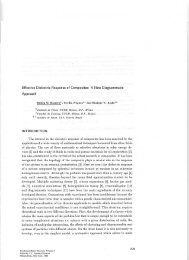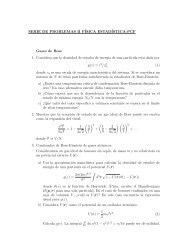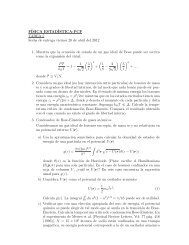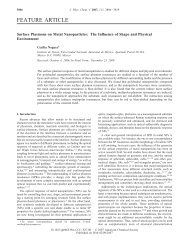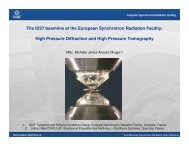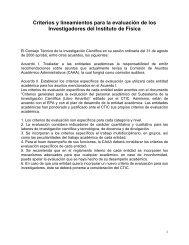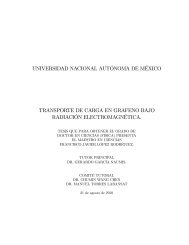Langmuir monolayers of C17, C19, and C21 fatty acids ... - UNAM
Langmuir monolayers of C17, C19, and C21 fatty acids ... - UNAM
Langmuir monolayers of C17, C19, and C21 fatty acids ... - UNAM
Create successful ePaper yourself
Turn your PDF publications into a flip-book with our unique Google optimized e-Paper software.
7022 J. Chem. Phys., Vol. 110, No. 14, 8 April 1999 S. Ramos <strong>and</strong> R. Castillo<br />
tilted phases with rectangular lattice symmetry, textures are<br />
also visible, but with much less contrast. This is probably<br />
due to the anisotropy <strong>of</strong> the unit cell herringbone alignment.<br />
Phase transitions are visible either as a dramatic<br />
change in the degree <strong>of</strong> contrast or as a sudden alteration <strong>of</strong><br />
the mosaic <strong>of</strong> textures <strong>and</strong> domain borders. Many <strong>of</strong> the<br />
textures <strong>and</strong> domain morphologies found in <strong>monolayers</strong> using<br />
the Brewster angle microscope BAM, have been explained<br />
using model calculations <strong>of</strong> <strong>monolayers</strong> with tilted<br />
molecules. 9,10,26<br />
The work <strong>of</strong> many different groups has contributed to<br />
obtain a general picture <strong>of</strong> the phase diagram <strong>of</strong> <strong>fatty</strong> acid<br />
<strong>monolayers</strong>, as well as, the structure <strong>of</strong> their phases using<br />
XRD, PFM, <strong>and</strong> Brewster angle microscopy. This picture<br />
can be reviewed as follows: At very low surface densities,<br />
when the average area per molecule, a, is much larger than<br />
the cross section area <strong>of</strong> an isolated molecule, an amphiphilic<br />
monolayer behaves as a two dimensional gas. Here, a molecule<br />
in a monolayer is still free to show all the conformational<br />
entropic contribution without any interference from<br />
neighbors. A first-order phase transition from the gas phase<br />
to a liquid-exp<strong>and</strong>ed LE phase is observed upon compression<br />
<strong>of</strong> the monolayer. LE phase is isotropic <strong>and</strong> molecules<br />
are tilted. The gas-phase side <strong>of</strong> the transition is <strong>of</strong> the order<br />
<strong>of</strong> a300– 1500 Å 2 /molec, whereas on the LE side a is <strong>of</strong><br />
the order <strong>of</strong> the cross section area <strong>of</strong> an isolated chain<br />
(30– 40 Å 2 /molec. A second phase transition to a liquid<br />
condensed LC state is observed upon further compression<br />
<strong>of</strong> the monolayer; a is <strong>of</strong> the order <strong>of</strong> 22– 25 Å 2 /molec. Here,<br />
a is just barely larger than the cross sectional area <strong>of</strong> a fully<br />
stretched all-trans chain. Actually, condensed phase is<br />
made up <strong>of</strong> a variety <strong>of</strong> mesophases, i.e., phases where the<br />
translational order <strong>of</strong> the molecules is short ranged <strong>and</strong> the<br />
orientational order <strong>of</strong> the bonds between the molecules is<br />
long range. At low surface pressures, there are several<br />
phases showing molecular tilt with distinct symmetry. L 2<br />
phase has a collective tilt towards a nearest neighbor<br />
NN. 14,16,20–22,24,30 L 2 <strong>and</strong> Ov phases tilt to a next-nearest<br />
neighbor NNN molecule. 14,16,20,22,24,30 The L 2 /Ov transition<br />
is quite peculiar, since it was found through BAM observations<br />
only, 17 since it cannot be detected with surface<br />
pressure-area isotherms, due to the lack <strong>of</strong> an area/molecule<br />
change during the transition. 16 At high pressure, there are<br />
two untilted phases, the super liquid phase, LS, 19–21,25 <strong>and</strong><br />
the solid phase, S. 14,19,20,23 Structure <strong>of</strong> mesophases can be<br />
locally hexagonal LS or distorted hexagonal, i.e., centered<br />
rectangular (L 2 , L 2 , Ov, S). In addition to mesophases,<br />
crystalline phases have been found with a positional quasilong-range<br />
order. They show positional correlations larger<br />
than 500 Å. They are CS <strong>and</strong> L 2 phases, both are centered<br />
rectangular with herringbone order. L 2 is at two-dimensional<br />
crystal with a NN-tilt 14 <strong>and</strong> CS is untilted. 14,22–25 At very<br />
high pressures, all phases collapse in multilayers. The details<br />
<strong>of</strong> the multilayering process are quite unknown. Textures <strong>of</strong><br />
condensed phases <strong>and</strong> the precise coexistence lines between<br />
phases have been obtained mainly using PFM <strong>and</strong> Brewster<br />
angle microscopy. This is the case for L 2 /L 2 <strong>and</strong> L 2 /CS<br />
transitions, 15 for L 2 /L 2 / L 2 transitions, 27 <strong>and</strong> many more presented<br />
with detail by Rivière et al. 18<br />
Tilt to an intermediate direction breaks the chiral symmetry<br />
<strong>of</strong> a monolayer. The breaking <strong>of</strong> inversion symmetry<br />
allows nonchiral molecules to arrange in chiral structures.<br />
Phases in which molecular tilt is intermediate between NN<br />
<strong>and</strong> NNN directions have been observed. Durbin et al., 13<br />
have found a intermediate phase I for a monolayer <strong>of</strong><br />
eicosanoic acid (C 20 ) using surface pressure-area isotherms<br />
<strong>and</strong> x-ray diffraction. These authors also found that the transition<br />
from I phase to an NN-tilted structure is first order,<br />
with a 60° change in the tilt direction, whereas, the transition<br />
to an NNN-tilted structure is apparently continuous.<br />
In this paper, we will present a detailed study to obtain<br />
all the boundaries in the phase diagrams <strong>of</strong> three <strong>fatty</strong> <strong>acids</strong>:<br />
Heneicosanoic (C 21 ), nonadecanoic (C 19 ), heptadecanoic<br />
(C 17 ), in the temperature range <strong>of</strong> 2 – 45 °C. A partial phase<br />
diagram <strong>of</strong> C 21 has been presented by Fischer et al. 29 Also<br />
for C 21 , Teer et al. 28 have presented a whole phase diagram,<br />
which has been obtained by shifting the temperature axis<br />
(6 °C per methylene group from other phase diagrams previously<br />
reported. 18 Our phase diagrams were determined using<br />
surface pressure-area isotherms <strong>and</strong> BAM observations.<br />
Therefore, in this paper, we will show the mosaic <strong>of</strong> texture<br />
<strong>of</strong> the phases as observed with the BAM, as well as, the<br />
phase transitions between those phases. Fatty <strong>acids</strong> with an<br />
odd carbon tail have been less studied than the case <strong>of</strong> even<br />
carbon tail <strong>acids</strong>. For the case <strong>of</strong> C 17 , we present the change<br />
<strong>of</strong> textures during the phase transformations: L 2 – Ov,<br />
Ov – LS, <strong>and</strong> L 2 – LS. As far as we know, they are not previously<br />
reported. The same phase changes are presented for<br />
C 19 , although we included the L 2 – L 2 , L 2 – LS, <strong>and</strong> L 2 – S<br />
transitions. C 21 is the richest phase diagram, since in addition<br />
to the mentioned phase transitions, we observed the L 2 – L 2<br />
<br />
<strong>and</strong> the L 2 – CS transformations at low temperatures. Also,<br />
we will report here a new intermediate phase for C 21 , which<br />
has been reported quite recently for the case <strong>of</strong> C 20 . 13 In<br />
addition, we will present an outst<strong>and</strong>ing observation made<br />
with the BAM in C 21 , which has not been reported before, as<br />
far as we know. We observed localized oscillations in the<br />
monolayer, in the crystalline phases L 2 <strong>and</strong> CS. Localized<br />
oscillations are related to energy <strong>and</strong> stress concentration in<br />
some relative large areas with high concentration <strong>of</strong> defects<br />
in the monolayer. They could be important in the events<br />
previous to the collapse.<br />
II. EXPERIMENT<br />
C 17 97%, C 19 99%, <strong>and</strong> C 21 99% were purchased<br />
from Aldrich U.S.A., <strong>and</strong> they were used without any further<br />
purification. With the aid <strong>of</strong> an spreading solution, <strong>fatty</strong><br />
<strong>acids</strong> were spread onto a subphase <strong>of</strong> ultrapure water<br />
Nanopure-UV at pH2. The spreading solution was made<br />
with chlor<strong>of</strong>orm Aldrich U.S.A., HPLC. HCl Merck,<br />
Mexico was used to modify pH.<br />
All <strong>monolayers</strong> were prepared on a computerized Nima<br />
<strong>Langmuir</strong>–Blodgett trough TKB 2410A, Nima Technology<br />
Ltd., Engl<strong>and</strong> using a Wilhelmy plate to measure the surface<br />
pressure 0 , i.e., the surface tension difference <strong>of</strong> the<br />
Downloaded 26 Feb 2003 to 132.248.7.15. Redistribution subject to AIP license or copyright, see http://ojps.aip.org/jcpo/jcpcr.jsp




